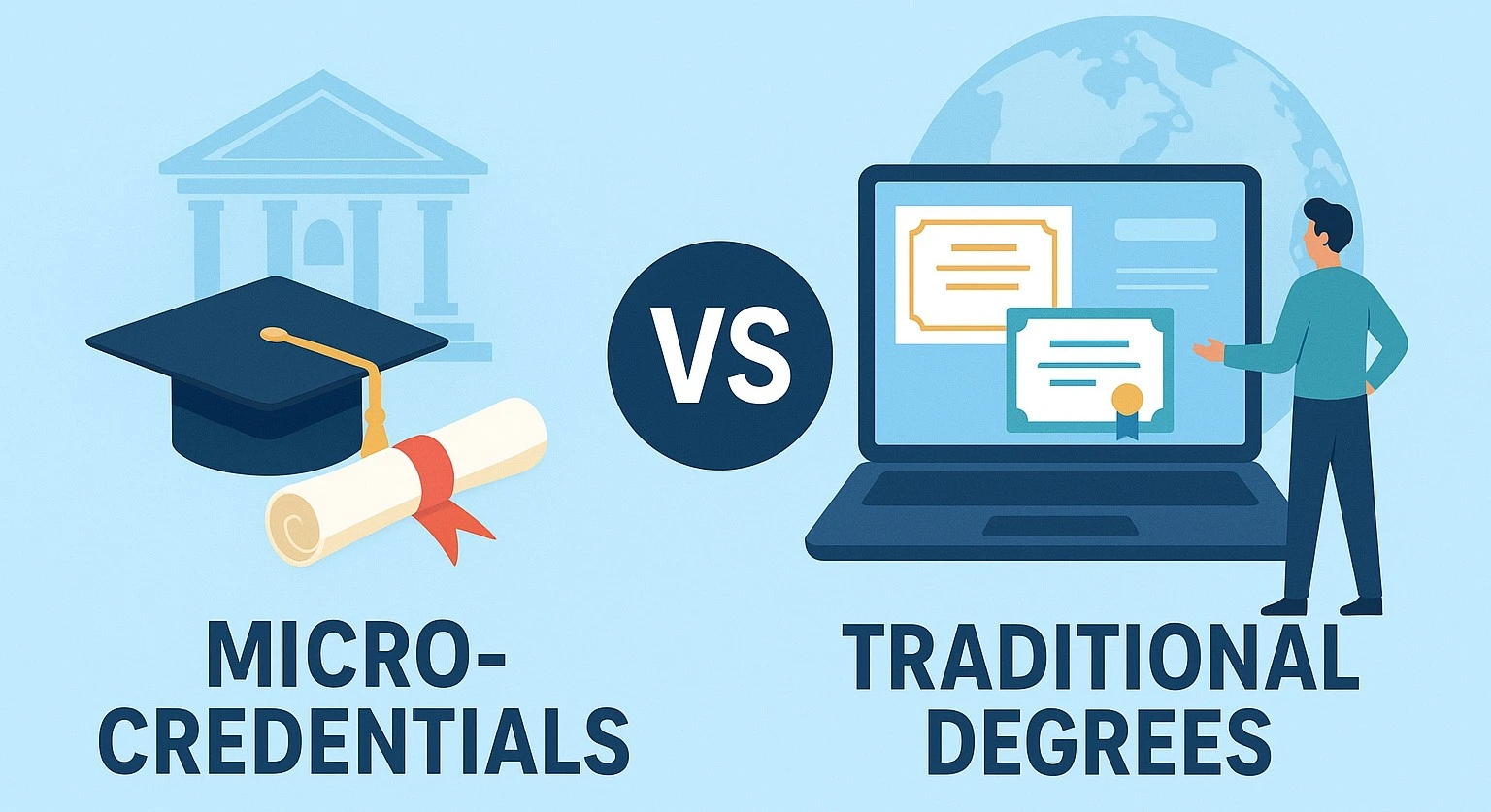For many years, the idea of success was tied to one simple path: go to school, get a degree, and then land a good job. Parents encouraged their children to aim for university because it was seen as the only ticket to financial freedom, respect, and professional growth. A degree was almost like a passport—it opened doors and created opportunities across the world.
But today, the world of work is evolving faster than ever. Technology, automation, and globalization have reshaped how people learn and how companies hire. We are now living in an era where having the right skills may matter more than just holding a certificate from a university. This shift has given rise to micro-credentials—short, targeted learning programs designed to quickly teach practical, job-ready skills.
Now the big question is: Will micro-credentials eventually replace traditional degrees, or will both coexist in shaping the future of careers worldwide? To answer this, let’s break it down in detail.
What Are Micro-Credentials?
A micro-credential is a short, skill-based course that helps you learn a specific ability in a short period of time. Instead of spending four years in university, you can spend a few weeks or months and acquire a professional certificate in areas like:
- Data Analytics
- Digital Marketing
- Project Management
- Web Development
- Cloud Computing
- Cybersecurity
Platforms like Coursera, LinkedIn Learning, Udemy, and edX have become global leaders in offering these courses. Many of them are created in partnership with top companies such as Google, IBM, and Microsoft.
For example, the Google Data Analytics Certificate on Coursera can be completed in less than six months. Once completed, it equips learners with practical tools like Excel, SQL, and Tableau—skills that employers value highly. Compare that to a four-year degree in statistics, which covers a wide range of topics but might take years before you reach the stage of using real-world tools.
What Is a Traditional Degree?
A traditional degree is an academic qualification earned after completing a structured program at a university or college. These programs are broad and in-depth, often lasting for:
- 3–4 years for a bachelor’s degree,
- 1–2 years for a master’s degree,
- and even longer for professional degrees such as medicine or law.
Degrees don’t just focus on technical skills; they also cover theories, research, critical thinking, and communication. For instance, a computer science degree may include courses in algorithms, programming, artificial intelligence, mathematics, and even ethics in technology. This broader approach helps graduates understand the bigger picture of their field.
Unlike micro-credentials, degrees are recognized globally, making them essential for careers in law, medicine, engineering, or government positions.
Micro-Credentials vs Traditional Degrees: A Detailed Comparison
Let’s look at both side by side:
1. Time Commitment
- Micro-Credentials: Can be completed in weeks or months. Perfect for people who need a quick skill upgrade.
- Degrees: Require years of study and a full commitment to the learning journey.
Example: A degree in computer science takes four years. Meanwhile, a micro-credential in web development may take three months and can still land you a decent entry-level job.
2. Cost
- Micro-Credentials: Often between $50 to $2,000, depending on the platform and course provider.
- Degrees: Range from $10,000 to $100,000+, especially in countries like the US or UK.
This cost gap makes micro-credentials more attractive to learners in developing countries who may not have the resources for a university education.
Read More: 10 Luxury Cars That Define Lifestyle in 2025: A Blend of Comfort, Class, and Innovation
3. Recognition
- Micro-Credentials: Gaining acceptance, especially in tech industries. Companies like Google, IBM, and Apple no longer require degrees for many jobs.
- Degrees: Still considered the gold standard by governments, universities, and many traditional employers.
4. Flexibility
- Micro-Credentials: 100% online and self-paced. Learners can study from home while working a full-time job.
- Degrees: Usually require in-person attendance, though online degree programs are becoming more popular.
5. Skill Depth
- Micro-Credentials: Focus on practical, hands-on skills that can be applied immediately.
- Degrees: Provide a broad foundation, preparing students not just for today’s jobs but also for long-term adaptability.
Why Employers Are Changing Their Views
The hiring landscape is shifting. For years, companies demanded degrees as a minimum requirement. But in the last decade, industries have started to prioritize skills over credentials.
Tech companies are leading this change. Google, Apple, and IBM openly stated that many of their roles no longer require traditional degrees. Instead, they test applicants’ abilities through projects, portfolios, and skill assessments.
Take software development as an example: A person who completed a coding bootcamp or a micro-credential program can sometimes secure a job even without a degree—if they can prove their skills.
But let’s be honest: not every field is like tech. Professions like medicine, law, teaching, and engineering still require degrees because they are regulated industries. No micro-credential will allow someone to become a surgeon or an architect.
Why Micro-Credentials Are Growing So Fast
Several forces are fueling the rise of micro-credentials:
- The Skills Gap – Many employers complain that fresh graduates lack the specific skills needed for modern jobs. Micro-credentials solve this by focusing directly on practical skills.
- Affordability – Students can avoid heavy student loans. For example, instead of paying $50,000 for a degree, someone could pay $300 for a course that teaches the exact skill they need.
- Flexibility – Busy professionals can learn at their own pace without quitting their jobs.
- Career Switching – Someone with a degree in history can take a micro-credential in digital marketing and switch careers within months.
- Industry Partnerships – Platforms like Coursera collaborate with major companies to design certificates that meet actual industry needs.
Why Degrees Still Matter
Despite the hype around micro-credentials, degrees are not going away anytime soon. Here’s why:
- Global Recognition – A degree from Harvard, Oxford, or even a respected local university is universally valued.
- Comprehensive Learning – Degrees don’t just teach technical skills. They also train students in communication, problem-solving, research, and leadership.
- Professional Requirements – Doctors, lawyers, and engineers need degrees because laws and regulations demand it.
- Networking Opportunities – University life provides valuable connections with professors, alumni, and peers—networks that often shape careers.
The Hybrid Future: Why We Need Both
The truth is that the future of education and careers lies in a hybrid model. The strongest professionals will not rely on one or the other but combine both.
Example:
- A student may pursue a degree in Computer Science for a solid foundation.
- Later, they can add micro-credentials in areas like Artificial Intelligence, Cloud Computing, or Cybersecurity to stay updated.
This hybrid path combines the depth of a degree with the speed and relevance of micro-credentials—a balance employers increasingly love.
Real-Life Examples
- The Self-Taught Coder
Many software engineers have built successful careers with coding bootcamps or micro-credentials. They didn’t need a degree, but they proved their skills through projects and portfolios. - The Traditional Path
In contrast, a doctor must complete years of university, clinical training, and residency. No shortcut exists because lives are at stake. - The Hybrid Professional
A marketing graduate might later take micro-credentials in SEO, content marketing, and data analytics to remain competitive in the digital-first world.
Which Should You Choose?
It depends on your career goals:
Choose Micro-Credentials if:
- You want to quickly enter the job market.
- You are looking to switch careers.
- You want a cost-effective way to upskill.
- You need a specialized skill for immediate use.
Choose Degrees if:
- You want international recognition.
- You are entering a regulated field (law, medicine, engineering).
- You want a long-term career foundation.
- You value research, leadership, and critical thinking.
Best Path: Combine Both
If possible, get a degree for foundation and add micro-credentials to stay relevant. This approach prepares you for both the present and the future.
The debate between micro-credentials and traditional degrees is not about one replacing the other. Instead, it’s about finding balance. Degrees provide depth and recognition, while micro-credentials offer speed and flexibility.
Next Article: Is The Redmi 15C 4G Worth Your Money? (Price and Specifications)
In the future, the most successful professionals will be those who combine both. A degree will lay the foundation, and micro-credentials will keep their skills fresh in an ever-changing job market.
So, as you plan your career path, ask yourself:
Do you want quick skills, long-term recognition, or a blend of both?
The answer may define not only your success but also the future of education and global careers.

